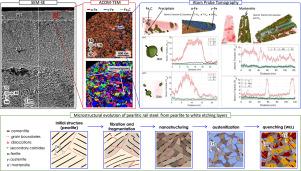Multiscale microstructural investigations of white and brown etching layers initiating the squat formation in pearlitic rail steels
IF 5.5
2区 材料科学
Q1 MATERIALS SCIENCE, CHARACTERIZATION & TESTING
引用次数: 0
Abstract
This study investigates the microstructural evolution of a pearlitic railway rail affected by squat defects, focusing on the microstructural gradients in the white and brown etching layers (WELs and BELs) below the rail surface. A multiscale characterisation of the rail microstructure is conducted using a combination of Scanning Electron Microscopy (SEM), Transmission Electron Microscopy with Automated Crystal Orientation Mapping (ACOM-TEM) mode, and Atom Probe Tomography (APT). The findings reveal that the microstructural gradient in the transformed layers consists of nanograins of carbon-saturated ferrite, twinned martensite, retained austenite, decomposed cementite, and secondary carbides. The presence of retained austenite suggests a thermal formation of the observed microstructure. The interaction between thermal driving forces and the effects of cumulative plastic deformations caused by wheel–rail interactions is discussed. It is suggested that while thermal forces drive the formation of the WEL/BEL microstructure, the tribological surface transformation (TST) occurs according to local equilibrium conditions. Specifically, the thermal driving force is enhanced by chemical driving forces resulting from the nanostructuring process of the rail microstructure prior to the WEL/BEL formation. Over subsequent wheel–rail contact cycles, the pearlitic microstructure experiences nanostructuring, leading to the formation of a dense network of grain boundaries, the fragmentation and decomposition of cementite, and the diffusion of carbon atoms (C) into ferrite by C-defects interactions. These transformations create a chemical driving force that lowers the energy barrier for austenite nucleation, ultimately resulting in the formation of martensite.

珠光体钢轨钢中引起深蹲形成的白色和棕色腐蚀层的多尺度显微组织研究
本文研究了深凹缺陷对珠光体铁路钢轨微观组织演变的影响,重点研究了钢轨表面以下白色和棕色蚀刻层(wel和bel)的微观组织梯度。使用扫描电子显微镜(SEM),带有自动晶体取向映射(ACOM-TEM)模式的透射电子显微镜和原子探针断层扫描(APT)模式对轨道微观结构进行了多尺度表征。结果表明:相变层的显微组织梯度由碳饱和铁素体、孪晶马氏体、残余奥氏体、分解渗碳体和次生碳化物组成。残余奥氏体的存在表明观察到的显微组织是热形成的。讨论了热驱动力与轮轨相互作用引起的累积塑性变形之间的相互作用。结果表明,在热作用力驱动WEL/BEL微观结构形成的同时,摩擦学表面转变(TST)是根据局部平衡条件发生的。具体来说,在WEL/BEL形成之前,钢轨微观结构的纳米化过程产生的化学驱动力增强了热驱动力。在随后的轮轨接触循环中,珠光体微观结构经历纳米结构,导致致密晶界网络的形成,渗碳体的破碎和分解,以及碳原子(C)通过C-缺陷相互作用扩散到铁素体中。这些转变产生了一种化学驱动力,降低了奥氏体成核的能垒,最终导致马氏体的形成。
本文章由计算机程序翻译,如有差异,请以英文原文为准。
求助全文
约1分钟内获得全文
求助全文
来源期刊

Materials Characterization
工程技术-材料科学:表征与测试
CiteScore
7.60
自引率
8.50%
发文量
746
审稿时长
36 days
期刊介绍:
Materials Characterization features original articles and state-of-the-art reviews on theoretical and practical aspects of the structure and behaviour of materials.
The Journal focuses on all characterization techniques, including all forms of microscopy (light, electron, acoustic, etc.,) and analysis (especially microanalysis and surface analytical techniques). Developments in both this wide range of techniques and their application to the quantification of the microstructure of materials are essential facets of the Journal.
The Journal provides the Materials Scientist/Engineer with up-to-date information on many types of materials with an underlying theme of explaining the behavior of materials using novel approaches. Materials covered by the journal include:
Metals & Alloys
Ceramics
Nanomaterials
Biomedical materials
Optical materials
Composites
Natural Materials.
 求助内容:
求助内容: 应助结果提醒方式:
应助结果提醒方式:


